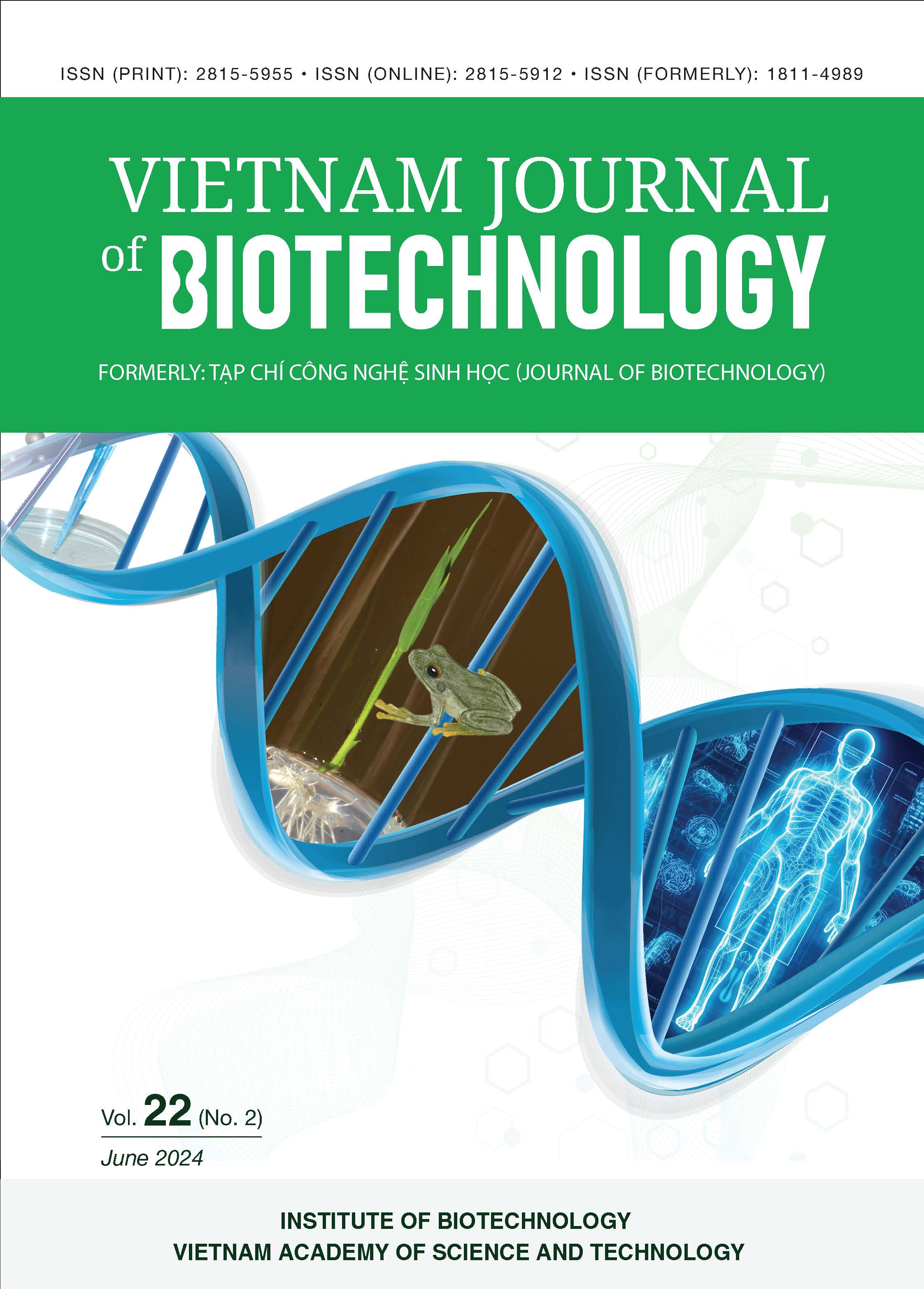Identification of a rare GLI3 variant associated with unilateral thumb polydactyly
Author affiliations
DOI:
https://doi.org/10.15625/vjbt-20720Keywords:
congenital anomaly, exome sequencing, GLI3, thumb polydactyly, zinc finger proteinAbstract
Polydactyly is a congenital anomaly marked by supernumerary digits, resulting in an excess number of fingers or toes. Numerous investigations have elucidated the critical role of genetic factors in determining the presence of non-syndromic polydactyly. Nevertheless, a comprehensive understanding of the underlying signaling pathway responsible for this disorder remains incomplete. In this study, we present a thorough analysis of a unique unilateral polydactyly phenotype in the thumb of a 6-year-old male proband, employing exome sequencing. The investigation revealed a rare heterozygous substitution variant (NM_000168.6:c.1384A>G; p.Lys462Glu) in the GLI3 gene, a critical factor associated with polydactyly. Sanger sequencing confirmed the paternal inheritance of this variant. Notably, the amino acid change demonstrated evolutionary conservation, emphasizing its potential functional significance. Our findings contribute novel insights into the genetic underpinnings of polydactyly, highlighting the significant role of GLI3 in limb development. This discovery expands our understanding of the broader implications of GLI3 mutations in congenital limb abnormalities, paving the way for further investigations in this field. From a genetic perspective, unraveling the intricacies of polydactyly at the molecular level opens avenues for comprehending the broader genetic landscape of limb malformations and their underlying mechanisms.
Downloads
References
Al-Qattan MM, Shamseldin HE, Salih MA, Alkuraya FS (2017) GLI3-related polydactyly: a review. Clin Genet 92(5): 457-466. https://doi.org/10.1111/cge.12952.
Biesecker L (2006) What you can learn from one gene: GLI3. J Med Genet 43(6): 465-469. https://doi.org/10.1136/jmg.2004.029181.
Bubshait DK (2022) A review of polydactyly and its inheritance: Connecting the dots. Medicine (Baltimore) 101(50): e32060. https://doi.org/10.1097/MD.0000000000032060.
Deng H, Tan T, Yuan L (2015) Advances in the molecular genetics of nonsyndromic polydactyly. Expert Rev Mol Med (17) e18. https://doi.org/10.1017/erm.2015.18.
Ishigaki T, Akita S, Suzuki H, Udagawa A, Mitsukawa N (2019) Postaxial polydactyly of the hand in Japanese patients: Case series reports. J Plast Reconstr Aesthet Surg 72(7): 1170-1177. https://doi.org/10.1016/j.bjps.2019.02.030.
Lange A, Nemeschkal HL, Müller GB (2014) Biased polyphenism in polydactylous cats carrying a single point mutation: the Hemingway model for digit novelty. Evol Biol 41: 262-275. https://doi.org/10.1007/s11692-013-9267-y.
Lettice LA, Hill AE, Devenney PS, Hill RE (2008) Point mutations in a distant sonic hedgehog cis-regulator generate a variable regulatory output responsible for preaxial polydactyly. Hum Mol Genet 17(7): 978-985. https://doi.org/10.1093/hmg/ddm370.
Matissek SJ, Elsawa SF (2020) GLI3: a mediator of genetic diseases, development and cancer. Cell Commun Signal, 18(1): 54. https://doi.org/10.1186/s12964-020-00540-x.
Nguyen TN, Nguyen TD, Do HQ, Nguyen DT, Hoang HD, Le TMH, Luong TLA, Nong VH (2020) Identification of novel missense mutations associated with non-syndromic syndactyly in two vietnamese trios by whole exome sequencing. Clin Chim Acta 506: 16-21. https://doi.org/10.1016/j.cca.2020.03.017.
Nguyen TN, Hoang HD (2021) Exome sequencing revealed the potential causal mutation in a Vietnamese patient with Apert syndrome. Gene Rep 22: 100995. https://doi.org/10.1016/j.genrep.2020.100995.
Nguyen TN, Tran GS, Hoang HD, Nguyen LG (2024) A novel missense variant located within the zinc finger domain of the GLI3 gene was identified in a Vietnamese pedigree with index finger polydactyly. Mol Genet Genomic Med, 12(6), e2468. https://doi.org/10.1002/mgg3.2468.
Rao C, Chen J, Peng Q, Mo Q, Xia X, Lu X (2018) Mutational Screening of GLI3, SHH, and SHH ZRS in 78 Chinese Children with Nonsyndromic Polydactyly. Genet Test Mol Biomarkers 22(9): 577-581. https://doi.org/10.1089/gtmb.2018.0096.
Sczakiel HL, Hulsemann W, Holtgrewe M, Abad-Perez AT, Elsner J, Schwartzmann S, Mensah MA (2021) GLI3 variants causing isolated polysyndactyly are not restricted to the protein's C-terminal third. Clin Genet 100(6): 758-765. https://doi.org/10.1111/cge.14059.
Sigafoos AN, Paradise BD, Fernandez-Zapico ME (2021) Hedgehog/GLI Signaling Pathway: Transduction, Regulation, and Implications for Disease. Cancers (Basel) 13(14). https://doi.org/10.3390/cancers13143410.
Singer G, Thein S, Kraus T, Petnehazy T, Eberl R, Schmidt B (2014) Ulnar polydactyly - an analysis of appearance and postoperative outcome. J Pediatr Surg 49(3): 474-476. https://doi.org/10.1016/j.jpedsurg.2013.06.029.
Umair M, Ahmad F, Bilal M, Ahmad W, Alfadhel M (2018) Clinical Genetics of Polydactyly: An Updated Review. Front Genet 9, 447. https://doi.org/10.3389/fgene.2018.00447.
Volodarsky M, Langer Y, Birk OS (2014) A novel GLI3 mutation affecting the zinc finger domain leads to preaxial-postaxial polydactyly-syndactyly complex. BMC Med Genet 15, 110. https://doi.org/10.1186/s12881-014-0110-9.
Downloads
Published
How to Cite
Issue
Section
Funding data
-
Vietnam Academy of Science and Technology
Grant numbers VAST01.04/23-24







